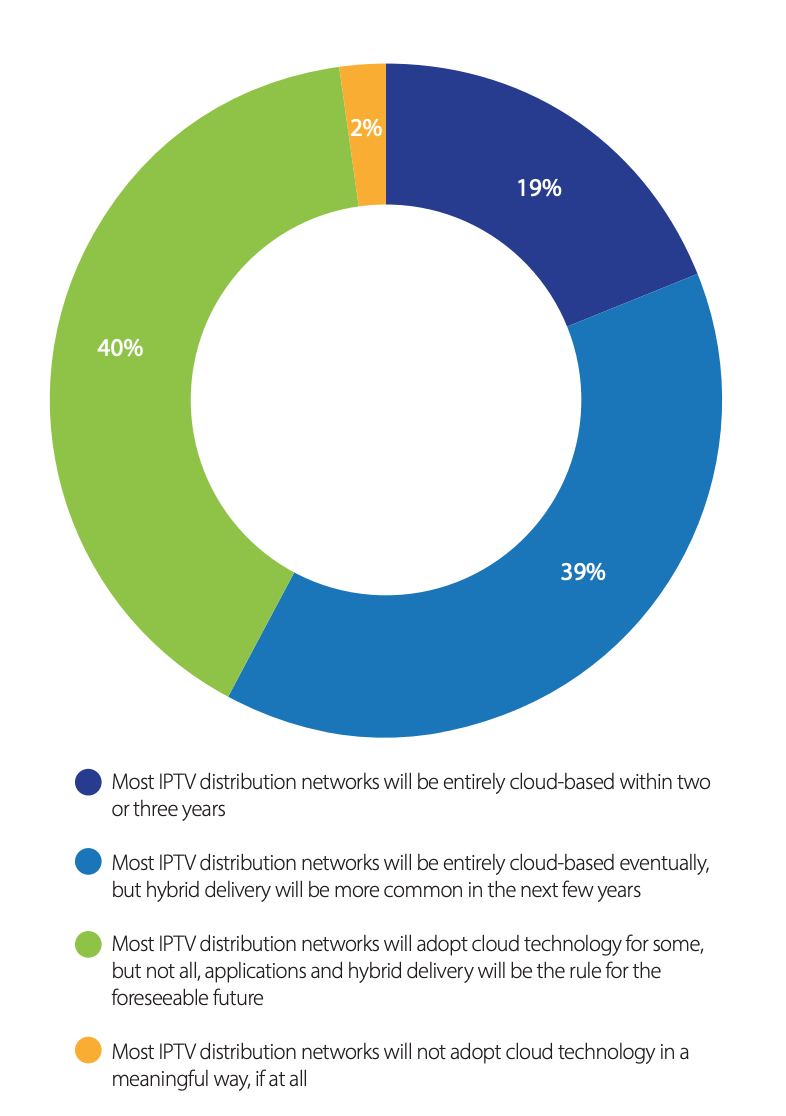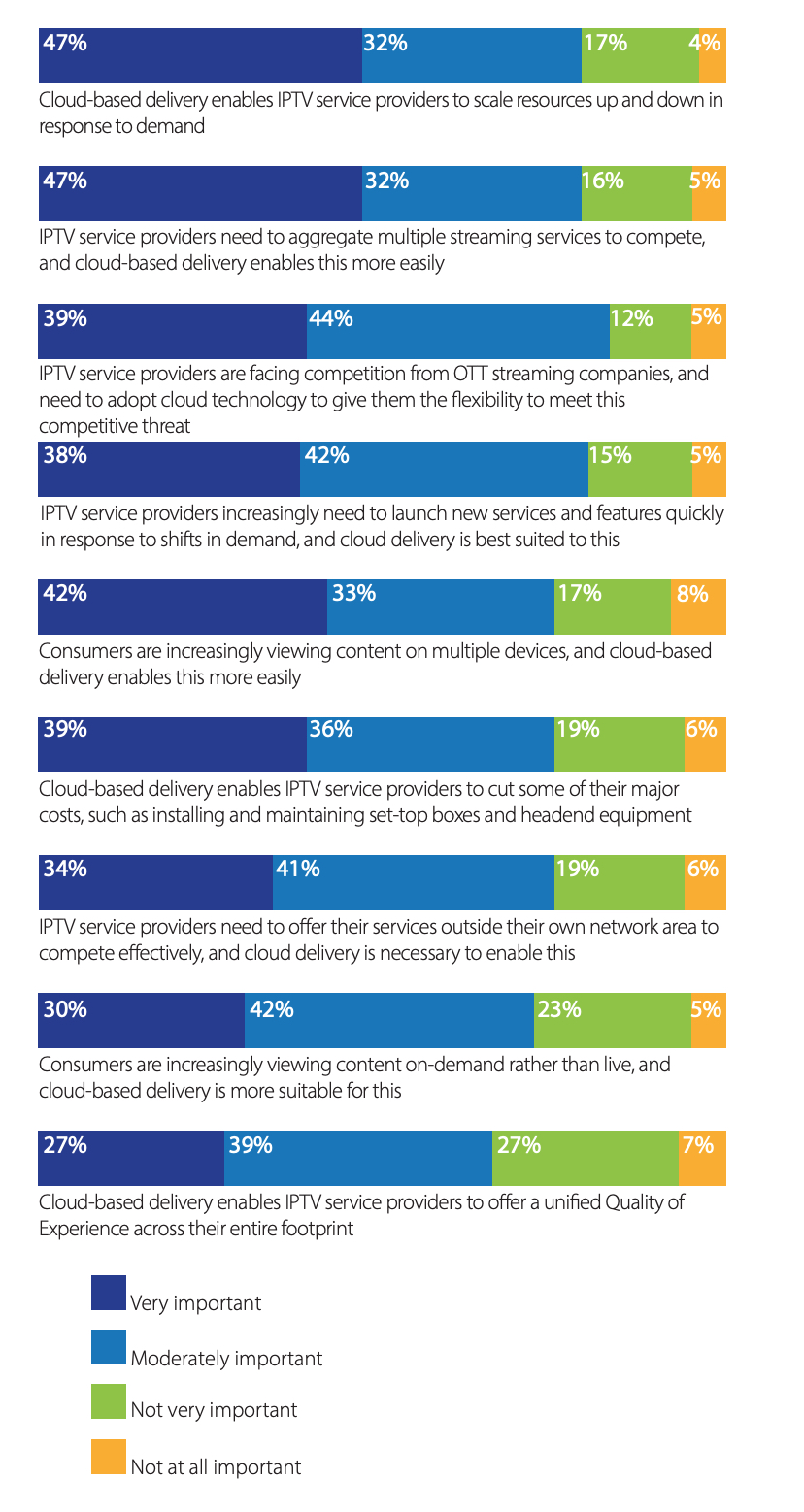The future’s in the clouds

IPTV services are increasingly adopting cloud technology, which can provide a more efficient, scalable way of delivering content to end users.
While there are differences of opinion about how fast and how far service providers should embrace the cloud, IPTV providers are under considerable pressure to optimise their delivery infrastructure, not only to manage costs more efficiently but to enable them to shift to a business model focused on aggregation of third-party services in addition or instead of marketing their own pay TV packages.
As a part of the Digital TV Europe Industry Survey 2021, we asked industry insiders about their views of what IPTV providers should be focusing on, what challenges they face, and how far cloud technology can provide a solution.
The evolution of IPTV
It is a truth universally acknowledged that modern video delivery systems are converging on IP, whatever the underlying physical infrastructure that gets the video feed from headend to home.
However, the extent to which IPTV video delivery should itself move to the cloud, enabling service providers to gain flexibility, scale their operations up and down quickly according to demand and account for the investment required as an operating expense line item rather than as capital expenditure, still divides opinion to some extent. While migrating video delivery to the cloud enables operators to gain flexibility, it arguably also presents a number of challenges.
This uncertainty informs responses to our survey. We asked survey respondents to give a view on how IPTV systems are likely to evolve, with reference to how far and how fast they will migrate from on-premises infrastructure to the cloud. Most respondents broadly accept that cloud represents the future of video.
A clear majority believe that most IPTV networks will become entirely cloud-based in the future, with some differences of opinion as to the timescale. Some 19% believe networks will be entirely cloud-based within two or three years, while a larger group – 39% of our sample – believe it will take a bit longer, with hybrid cloud-on-premises-based systems being more common for some time.
There is however a significant group who dissent from the mainstream view that total cloudification is on the way. Two in five respondents believe that IPTV network operators will adopt cloud technology for some but not all applications and that hybrid delivery will be the rule for the foreseeable future.
This group accepts that cloud technology will have a role to play but resist the idea that all on-premises infrastructure will inevitably disappear. Importantly, only around 2% of respondents take the cloud-sceptic view that most IPTV networks will not adopt the technology in any meaningful way.
Driving adoption
While the shift to streaming during the pandemic has clearly a role to play, a number of secular factors are driving adoption of cloud technology.
In the view of survey respondents, two of these factors stand out – the fact that cloud-based delivery can enable service providers to scale resources up and down quickly in response to shifts in demand and the way in which it enables them more easily to take on the role of ‘super-aggregators’ of third-party content services.
Four out of five respondents believe that the scalability of cloud-based video delivery is very important or moderately important as a driver of adoption, with a majority of those believing it to be very important. Similar numbers of respondents believe in the importance of cloud as enabler of the aggregation model for service providers, increasingly seen as a key strategy in the battle for consumers and a way for IPTV providers to remain relevant in an era of accelerating adoption of OTT streaming services.
Other factors that score particularly highly for importance include the need for flexibility to compete with OTT streamers and the related need to be able to launch new services and features quickly in response to shifts in demand.
Slightly further down the list, but still very important as drivers of cloud adoption, are the tendency of consumers to view content on multiple devices, more easily served from the cloud, and the way cloud technology can enable operators to cut major costs such as installing and maintaining set-top boxes and on-premises headend equipment.
Another factor seen as somewhat important is the way cloud delivery enables service providers more easily to offer their services outside their own network areas.
The shift of consumption from live to on-demand viewing is seen as a moderately important factor, while the ability of cloud-based delivery to enable a unified Quality of Experience across an entire footprint is also seen as important, but relatively less so.
Cloud challenges
While the benefits of the cloud have clearly been identified, there still remain hurdles that need to be overcome should operators want to fully embrace the cloud.
We asked our survey respondents to rate five key challenges to cloud migration. Most were rated similarly in terms of their importance. However, the most pressing challenge, in the view of our sample, is that cloud technology is not optimised for live linear channel delivery. However efficient it might be in theory to deliver all services from the cloud, there is still a perception that delivery of live linear channels is managed more efficiently using one-to-many broadcast technology.
The same applies to large-scale live event coverage more broadly. Survey respondents endorse the view that the technology is not optimised for providing coverage of, say, live premium sports.
A related complaint is that cloud technology’s use of adaptive bit-rate video can potentially compromise Quality of Experience. If demand scales up too quickly relative to the bandwidth available, lower quality streams for all viewers can kick in too abruptly before the system has time to adjust. This is clearly a challenge that is again most closely associated with live events and can be particularly damaging if UHD quality is offered at a premium.
The next biggest challenge, in the view of survey respondents, is that IPTV service providers lack the expertise necessary to migrate to cloud technology quickly. The absence of the relevant skillsets and the related challenge of organisational resistance to change can be significant factors in slowing up adoption.
Of relatively less importance, in the view of survey respondents, is the view that cloud technology is intrinsically complex and costly to manage and maintain. It is important to mention that a narrow majority of respondents do in fact view complexity and cost as either very important or moderately important, but a significant minority dissent from that view. It is probably fair to say that cost and complexity are declining in importance as cloud technology is adopted more widely and innovation proceeds apace.
Ultimately at present, the big challenge to universal adoption of cloud technology is that it is arguably not the most efficient way to deliver linear channels and live event coverage.
The future
IPTV service providers are adopting cloud technology, but how fast – and how far – they will do so remains a matter of debate. While the benefits of cloud technology are now well-known, a number of challenges remain – notably that of delivering live linear channels and event coverage at scale.
The key benefits of migrating IPTV services to cloud-based delivery are that it more easily enables service providers to scale up and down according to demand and enables them more easily to aggregate content from multiple sources. The COVID-19 pandemic, leading to a surge in demand for streaming services as well as investment in cloud systems generally, is likely to accelerate adoption of cloud technology by IPTV services.
Cloud technology can help enable what are increasingly the compelling differentiators for IPTV – its ability to aggregate multiple services in one place and to provide a compelling unified user experience, including universal search and recommendation, across all those content sources. This universal search and recommendation is a key unique selling point and the foundation stone of the emerging ‘super aggregator’ model.
This piece is adapted from a section sponsored by TiVo in the Digital TV Europe Industry Survey 2021. To read the full report for free click here.






